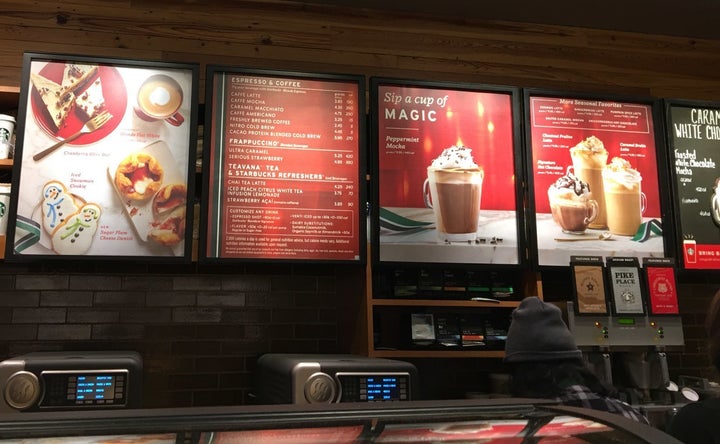
When it comes to coffee shop menus, less has become more. Those long lists of drinks, bean varieties, teas, non-caffeinated beverages, sizes and prices are shrinking, and Starbucks is leading the way.
The coffee chain known for offering everything that you could possibly want inside of a cup has Marie Kondo’d its store menus. Upon entering any given Starbucks, you’ll look above the barista to find a trimmed list of select drinks priced out at the Grande (medium) size and a corresponding calorie count. You might also find a few photos of seasonal beverages or an illustrative breakdown of a new offering.
According to a spokesperson for Starbucks, the move to focus only on core and select seasonal beverages was rolled out this past spring in an effort to “simplify the ordering experience for our customers.” However, it wasn’t a complete spring clean. The chain still offers its usual size range (Tall, Grande, Venti) and every drink that used to be featured — but you’ll only see the prices and offerings in the Starbucks app, which now accounts for 14 percent of store transactions.
For regulars who could order and pay for a Venti Java Chip Frappuccino in their sleep, the change isn’t really going to disrupt their routine. But for the casual customer who visits the Shrewsbury, New Jersey, Starbucks on a November afternoon for a rare treat, they might (understandably) think that their choices are limited to the 12 options listed. The question is: Does this customer even mind having fewer options?
“I think [a streamlined menu] is easier for customers to understand — a super complicated menu can be daunting.”
- Ashley Rodriguez, barista and online editor for Barista Magazine
“I think [a streamlined menu] is easier for customers to understand — a super complicated menu can be daunting,” said Ashley Rodriguez, online editor for Barista Magazine and a barista in the Bay Area. “And just because there’s words on a menu, it doesn’t mean a customer understands them.”
For example, a customer may see three sizes and prices listed for a latte, but won’t know just how many shots of espresso are in each. Or, someone who has never ventured beyond a standard coffee might not even know what goes into a latte to begin with. In these cases, customers have a bit more clarity with a menu that doesn’t list a latte outright.
“I see places that have an option for ‘espresso and milk,’ which means customers can say just how much milk they want, from a splash to a big 20-ounce latte. In this scenario, baristas are encouraged to figure out what a customer actually wants,” Rodriguez told HuffPost. If a menu does list a latte, editing out other options keeps questions to a minimum while also giving a barista an opportunity to craft a drink to the customer’s specifications.
A concise menu benefits baristas and customers ― but also the café. “The sooner a guest finds their item, the happier they will be,” said Gregg Rapp, a menu engineer with 36 years of experience in the field. “The guest will buy more items if it is easy to navigate the menu. When they have to search the menu and get confused, the guest will order a ‘default’ item, an item that is easy and safe.”
Clearing up menu space also makes room to offer details on specialty beverages that may command higher prices. According to Rapp, this emphasis on a select product has a powerful effect on customers’ buying habits. “The value goes up in the guest’s mind and the price seems lower with more description,” he told HuffPost. “So yes, the more description, the more ‘work’ to get through the menu, but you’re helping the guest and building value into the items.”
Though offering fewer items on the menu could be profitable, this design helps highlight the true specialties of the house instead of the more everyday items — a good reason the trend could go beyond cafes. “Less choice isn’t about serving less, especially in coffee shops, than it is about creating a streamlined experience showcasing what you’re best at,” said Briana Volk, owner and creative director of the restaurants Little Giant and Portland Hunt + Alpine Club in Portland, Maine. “At Little Giant, we have recently taken our burger off the menu as an offering, but still make it and serve it. It creates a conversation between us and our guests which can help us provide a more personal experience,” she told HuffPost.
Whether you’re ordering a burger or a mocha, curated menus may become the new norm. Until then, you’ll now know why there are a dozen Grande Peppermint Lattes lined up at the bar at Starbucks — and why you should consult the Starbucks app if you want to see the options for a hot tea.